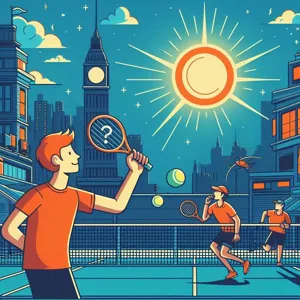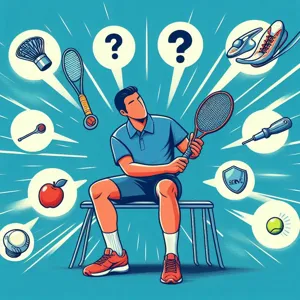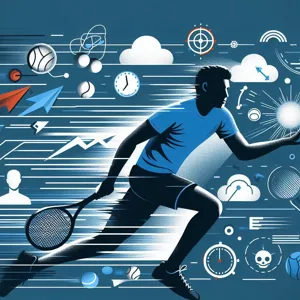In the competitive world of sports, the difference between a good player and a great one often comes down to the intricacies of technique and training.
For tennis enthusiasts, volleyball players, and badminton aficionados alike, the serve is not just a fundamental skill; it’s a powerful weapon that can set the tone for the entire game. But how do you transform a standard serve into an explosive one that leaves your opponents scrambling? In this blog post, “Unlocking Power: Proven Techniques to Boost Your Serve Speed,” we will delve into the science behind serve acceleration and explore effective drills, strength-building exercises, and expert tips that can elevate your performance on the court. Whether you’re a seasoned athlete or just starting, these actionable strategies will help you harness your full potential, making your serves not only faster but also more precise and impactful. Get ready to serve up success!
1. Understanding Serve Speed: The Fundamentals

To unlock the full potential of your serve, it’s crucial to first understand the fundamentals of serve speed. Serve speed is not merely about how hard you can hit the ball; it’s a complex interplay of technique, body mechanics, and timing. The serve is one of the most critical shots in tennis, as it sets the tone for each point and can give you a significant advantage over your opponent.
At its core, serve speed is influenced by several key factors: grip, stance, and body rotation. The grip you choose affects how you make contact with the ball; a continental grip, for example, allows for a versatile range of serves, from flat to kick. Your stance, whether it’s platform or pinpoint, plays a role in your balance and ability to generate power.
Equally important is the kinetic chain, which refers to the sequence of movements that generate force. This starts from your feet and legs, moves through your core, and culminates in your arm and racket. Engaging your legs effectively to push off the ground can significantly increase your initial momentum, while a strong core rotation allows you to transfer that energy into the racket.
Timing is also essential; the moment of contact with the ball can make or break your serve. Striking the ball at the apex of your toss can help you achieve maximum speed and spin, making it more difficult for your opponent to return.
By mastering these fundamentals, you can lay a solid foundation for improving your serve speed. Remember, it’s not just about hitting the ball hard; it’s about hitting it smart. Understanding these principles will empower you to refine your technique, leading to faster serves and, ultimately, a more formidable game.
2. The Importance of Serve Speed in Tennis
Serve speed is a crucial element in the game of tennis, acting as a powerful weapon that can dictate the pace of play and influence the outcome of points. The serve is often the first opportunity a player has to take control of a rally, and a faster serve can put immediate pressure on the opponent. When executed effectively, a high-speed serve not only makes it challenging for the receiver to return the ball but also increases the likelihood of scoring aces or forcing weak returns that can be easily capitalized on.
In competitive matches, the significance of serve speed cannot be overstated. It can create a psychological edge, instilling a sense of urgency and intimidation in the opponent. Players with a strong serve can often dictate the flow of the game, allowing them to transition seamlessly into aggressive net play or powerful groundstrokes. Furthermore, serve speed can be the difference-maker in close matches, where every point counts, and a well-timed, fast serve can swing momentum in a player’s favor.
However, it’s not just about raw speed. The effectiveness of a serve also relies on precision and placement. A fast serve that lands in the middle of the service box may be easily returned, while a slightly slower serve directed to the corners can catch an opponent off guard. This interplay between speed and accuracy is what makes mastering serve speed so essential for any serious tennis player. By understanding and honing the importance of serve speed, players can unlock their full potential on the court, turning their serve into one of their greatest assets.
3. Analyzing Your Current Serve Technique

Analyzing your current serve technique is a crucial step in unlocking the full potential of your serve speed. Before you can make improvements, it’s essential to understand where you stand and identify the specific elements of your technique that may be holding you back. Start by recording yourself during practice sessions or matches. Watching the footage allows you to observe your stance, grip, toss, and follow-through in a way that’s difficult to do in real-time.
As you review your serve, pay close attention to your foot positioning. Are your feet shoulder-width apart for stability? Do you transfer your weight effectively from your back foot to your front foot during the serve? A solid foundation is key to generating power, and any imbalance can limit your speed significantly.
Next, focus on your grip and racket angle. An improper grip can lead to inconsistent ball contact and reduced speed. Experiment with different grips and find what feels comfortable while allowing for maximum racket head speed. Also, be mindful of how your racket faces the ball at contact; a slight adjustment here can lead to a more explosive serve.
The toss is another critical component that often goes overlooked. A consistent, well-timed toss allows you to hit the ball at the peak of your reach, maximizing your power. If your toss is too high, too low, or erratic, it can throw off your entire serve. Practice your toss separately, ensuring it’s both reliable and repeatable.
Finally, don’t forget to analyze your follow-through. A strong follow-through not only helps with balance but also indicates how well you’ve transferred your energy into the serve. A weak finish can suggest that you’re not using your entire body to generate speed.
By diligently analyzing these components of your serve technique, you’ll gain invaluable insights that will pave the way for improvements. Consider seeking feedback from a coach or experienced player to help you identify blind spots. With this focused approach, you can refine your serve and unlock the power needed to dominate your matches.
4. Strength Training for Power Generation
When it comes to boosting your serve speed, strength training is an essential component that often gets overshadowed by more glamorous techniques like agility drills or flexibility routines. However, building a solid foundation of strength is crucial for generating the explosive power needed for a dominant serve.
Strength training not only enhances your overall physical conditioning but also specifically targets the muscles involved in the serving motion. Focus on exercises that engage the core, legs, and shoulders, as these muscle groups play a pivotal role in your ability to generate force. Movements such as squats, deadlifts, and bench presses will help build the necessary strength in your lower body and upper body, while core exercises like planks and medicine ball twists will stabilize your trunk during the serve.
Incorporating plyometric exercises into your routine can further amplify your power generation. Explosive movements such as box jumps, medicine ball slams, and plyometric push-ups are designed to enhance your fast-twitch muscle fibers, which are crucial for quick, powerful bursts of energy.
Moreover, don’t overlook the importance of proper form and technique during strength training. Focus on controlled movements that mimic the biomechanics of a serve. This will not only improve your strength but also translate directly into more powerful serves on the court.
As you progress, consider working with a coach or trainer who can tailor a strength training program specifically for your needs. By committing to a structured strength training regimen, you’ll not only boost your serve speed but also enhance your overall performance, making you a formidable opponent on the court. Remember, power generation begins in the gym; with dedication and the right approach, you can unlock your full serving potential.
5. Developing Core Stability for a Stronger Serve

Developing core stability is essential for achieving a stronger serve, yet it’s often overlooked by players focused solely on upper body strength. Your core is the powerhouse of your body, acting as the central link that connects your upper and lower body during a serve. A stable core not only enhances your overall balance but also ensures that your energy is effectively transferred from your legs through your torso and into your arms, resulting in a faster, more powerful serve.
To build this crucial stability, incorporate exercises that target the entire core, including the abdominals, obliques, and lower back. Planks, Russian twists, and medicine ball rotations are excellent choices that promote strength and endurance in your core muscles. Additionally, balance exercises like single-leg stands or stability ball workouts can greatly improve your proprioception, helping you maintain control and power during your serve.
Another key aspect of core stability is proper posture. When serving, maintaining an upright and aligned posture allows for efficient movement and optimal energy transfer. Focus on engaging your core throughout your serve, from the moment you start your wind-up to the instant you make contact with the ball. This engagement will not only enhance your serve speed but also reduce the risk of injury by providing a solid foundation for your movements.
As you develop core stability, remember to integrate it into your practice routine. Consistent training will lead to noticeable improvements in your serve speed, giving you the competitive edge you need on the court. By prioritizing core strength, you unlock the potential for a more powerful, accurate, and effective serve that can leave your opponents scrambling.
6. The Role of Footwork and Positioning
When it comes to enhancing your serve speed, many players overlook a fundamental aspect: footwork and positioning. Yet, these elements are crucial in setting the stage for a powerful serve. Imagine your body as a coiled spring—proper footwork helps to compress that spring before the release, maximizing energy transfer and propelling the ball at incredible speeds.
To begin with, effective footwork allows you to position yourself optimally behind the ball. This means approaching the service line with a light, agile stance that enables quick adjustments. Whether you’re serving from the deuce or ad side, your feet should be shoulder-width apart, ready to pivot and react. The first step is to establish a solid base; the next is to ensure your weight is distributed correctly as you prepare to strike. This balance will not only contribute to your speed but also enhance your accuracy and consistency.
As you initiate your serve, focus on your footwork sequence. A well-timed toss should be complemented by a swift, explosive movement from your legs. Engage your lower body by pushing off the ground as you transfer your weight from your back foot to your front foot. This kinetic chain—from your feet through your legs and into your torso—creates a powerful momentum that translates into increased racket head speed.
Additionally, the positioning of your body in relation to the ball is equally vital. Align yourself so that your shoulders and hips are square to the net as you make contact. This alignment not only improves the direction of your serve but also allows for a more fluid motion, harnessing the full power of your core muscles.
Incorporating footwork drills into your training regimen can further sharpen this skill. Practice lateral movements, quick sprints, and shadow serves to enhance your agility and responsiveness on the court. Remember, the faster and more efficiently you can move into position, the more explosive your serve will be. By mastering your footwork and positioning, you’ll unlock the potential for a serve that not only boasts remarkable speed but also precision, keeping your opponents on their toes and elevating your overall game.
7. Perfecting Your Grip and Racket Angle

Perfecting your grip and racket angle can be a game-changer when it comes to boosting your serve speed. The way you hold your racket not only influences your control but also impacts the energy transfer from your body to the ball. A firm yet relaxed grip is essential; it allows for fluid motion while maintaining the strength needed for a powerful serve.
Start by experimenting with different grips, such as the continental grip, which is favored by many players for its versatility and effectiveness. This grip enables you to hit a variety of serves, from slice to topspin, while maintaining the ability to generate speed. As you grip the racket, ensure that your fingers are spread comfortably around the handle, allowing for maximum leverage without causing tension in your wrist or forearm.
Next, focus on the racket angle at the point of contact. An optimal racket angle can enhance the ball’s trajectory and speed significantly. Position your racket head slightly above the ball, aiming for a downward angle as you make contact. This not only helps in imparting spin but also contributes to the initial velocity of the serve. Visualize yourself launching the ball into the air, with your racket cutting through the air like a knife; the sharper the angle, the faster and more explosive the serve.
Remember, practice is key. Devote time to refining your grip and racket angle during training sessions. Incorporate drills that allow you to focus solely on these elements, gradually increasing your serve speed as you become more comfortable with the mechanics. By perfecting your grip and racket angle, you’ll not only elevate your serve speed but also gain confidence in your overall game, unlocking the true power behind your serve.
8. Utilizing Dynamic Stretching and Warm-Up Routines
When it comes to enhancing your serve speed, neglecting an effective warm-up routine is a common pitfall that many athletes encounter. Dynamic stretching and a well-structured warm-up are not just preparatory rituals; they are essential components that can significantly elevate your performance on the court.
Dynamic stretching involves active movements that mimic the actions you’ll perform during your serve, promoting flexibility and increasing blood flow to the muscles. Unlike static stretching, which can leave your muscles feeling lethargic, dynamic stretching engages your body in a way that primes it for explosive action. Think leg swings, arm circles, and torso twists—each movement should be performed with purpose and intensity to activate the muscle groups you’ll be relying on.
Begin your warm-up with light aerobic activity, such as jogging or skipping, to gradually raise your heart rate. Follow this with dynamic stretches tailored for tennis players, focusing on the shoulders, hips, and legs. For instance, incorporate walking lunges with a twist to enhance hip flexibility, or use high knees to activate your core and leg muscles. These movements not only improve your range of motion but also enhance coordination and balance, which are crucial for a powerful serve.
As you warm up, consider adding specific drills that mimic the serving motion. Practicing your toss and swing without hitting the ball can help reinforce muscle memory and establish a rhythm. This preparation not only helps prevent injury but also builds confidence as you step onto the court.
Incorporating dynamic stretching and warm-up routines into your pre-game preparations is akin to unlocking a hidden level of your potential. By investing just a short amount of time in these practices, you’ll find yourself not only serving faster but also with greater accuracy and consistency, setting the stage for an exhilarating match. Embrace this technique, and watch as your serve speed—and your game—soar to new heights.
9. The Benefits of Plyometric Exercises
Plyometric exercises are a game-changer when it comes to enhancing your serve speed. Often referred to as “jump training,” these dynamic movements focus on explosive power and agility, making them an essential component of any athlete’s training regimen. The core principle behind plyometrics lies in the stretch-shortening cycle of muscles, which means that by rapidly stretching a muscle (eccentric phase) and immediately contracting it (concentric phase), you can generate a greater force output.
Incorporating plyometric exercises into your training routine can yield a multitude of benefits. Firstly, these exercises improve your overall muscle power, allowing you to harness more strength during your serve. Think box jumps, medicine ball throws, and explosive push-ups; each movement pushes your muscles to their limits, enhancing their ability to exert force quickly. This translates directly to a more powerful serve on the court.
Additionally, plyometrics increase your coordination and balance. By engaging in these high-intensity movements, you develop better neuromuscular control, which is crucial for executing a precise and powerful serve. Enhanced coordination helps in timing your serve effectively, ensuring that every muscle in your body works in harmony to achieve maximum speed and accuracy.
Furthermore, plyometric training can significantly improve your stamina and endurance. This is particularly beneficial in a sport like tennis, where matches can be long and physically demanding. By incorporating plyometrics into your fitness program, you’ll build the explosive strength needed for those critical moments when you need to serve at your best, all while maintaining your energy levels throughout the match.
In summary, integrating plyometric exercises into your training can skyrocket your serve speed by boosting muscle power, improving coordination, and enhancing endurance. So, lace up your sneakers, find a sturdy box, and start jumping your way to a faster serve!
10. Mental Strategies for Boosting Confidence and Focus
Mental strategies play a crucial role in enhancing your serve speed by boosting your confidence and focus. In the high-pressure environment of competitive sports, the mind often influences physical performance as much as physical training does. To unlock your full potential, consider incorporating these techniques into your routine.
**Visualization:** One of the most powerful tools in sports psychology is visualization. Take a few minutes before your practice or match to close your eyes and vividly imagine yourself executing the perfect serve. Picture every detail—from your stance and grip to the fluid motion of your arm and the ball soaring over the net. This mental rehearsal not only boosts your confidence but helps familiarize your mind with success, ultimately making it feel more achievable on the court.
**Positive Self-Talk:** The dialogue you have with yourself can significantly impact your performance. Replace negative thoughts with affirmations that reinforce your capabilities. Phrases like “I serve with precision and power” or “I am in control” can enhance your confidence. Repeat these affirmations regularly, especially before matches, to cultivate a mindset of positivity and self-assurance.
**Breathing Techniques:** Anxiety and nerves can hinder your ability to serve effectively. Incorporate breathing exercises into your warm-up routine to help calm your mind and body. Deep, controlled breaths can alleviate tension and focus your thoughts. For instance, try inhaling deeply for a count of four, holding for four, and exhaling for four. This rhythmic breathing helps to ground you, enabling you to approach each serve with clarity and poise.
**Mindfulness and Presence:** Practicing mindfulness can sharpen your focus and presence during matches. By staying fully engaged in the moment, you reduce distractions and enhance your ability to perform under pressure. Techniques such as meditation or simple grounding exercises—like paying attention to the feel of the racket in your hand or the sound of the ball hitting the court—can help you stay anchored and ready to serve.
By implementing these mental strategies, you not only improve your serve speed but also cultivate a resilient mindset that allows you to thrive under pressure. Remember, confidence and focus are as critical as physical skill in achieving peak performance on the court. Embrace these techniques, and watch as they transform not only your serve but your overall game.
11. Video Analysis: Learning from the Pros
In the world of tennis, mastering your serve isn’t just about strength and technique; it’s about constant refinement and adaptation. One of the most effective ways to elevate your serve speed is through video analysis, a technique increasingly adopted by both amateurs and professionals alike. By capturing your serving motion on video, you open the door to a wealth of insights that can transform your game.
Imagine setting up a camera on the court, recording your serves from various angles. This simple yet powerful tool allows you to dissect every aspect of your technique. As you watch the footage, you can pinpoint areas that need improvement—whether it’s your grip, stance, or follow-through. Noticing small details that you might otherwise overlook in the heat of the moment can lead to significant enhancements in your performance.
To further enhance your learning, consider comparing your footage to that of professional players. Analyzing the serves of top athletes, such as Novak Djokovic or Serena Williams, provides a benchmark for what optimal technique looks like. Pay attention to their body positioning, timing, and rhythm. What sets them apart? How do they generate that explosive power? By identifying these key elements, you can make informed adjustments to your own serve.
Moreover, sharing your recordings with a coach or a fellow player can provide additional perspectives. They may catch nuances that you miss and offer constructive feedback, allowing for a collaborative approach to your improvement.
Incorporating video analysis into your training routine not only accelerates your learning process but also keeps you motivated. Watching your progress over time—how your technique evolves, how your serve speed increases—can be incredibly rewarding. So, grab your camera, hit the court, and start unlocking the full potential of your serve with the power of video analysis!
12. Incorporating Drills to Enhance Serve Speed
Incorporating drills into your training regimen is a game-changer when it comes to enhancing your serve speed. These targeted exercises not only help build strength and coordination but also instill the muscle memory necessary for a powerful serve. To get started, consider dedicating specific practice sessions solely to serve drills, ensuring you have ample time to focus on technique and execution.
One effective drill is the **Toss and Strike** exercise. Begin by practicing your ball toss without hitting the ball, focusing on consistency and height. Once you’re comfortable, incorporate the strike, emphasizing the fluid transition from toss to swing. This drill sharpens your timing, allowing you to develop a rhythm that translates to increased speed.
Another excellent drill is the **Power Serve Progression**, which involves gradually increasing your serve intensity. Start with half your usual power, focusing on form and follow-through. As you gain confidence, increase your power incrementally. This approach allows you to maintain control while pushing your limits, ultimately leading to a faster, more forceful serve.
Don’t overlook the importance of footwork in serving. Incorporate agility drills, such as lateral shuffles or cone drills, to improve your foot speed and positioning. A well-timed, agile approach to the baseline sets the stage for an explosive serve.
Finally, consider video analysis or feedback from a coach. Recording your serves can reveal areas for improvement you might not notice in real-time, allowing you to hone your technique further. By consistently integrating these drills into your practice routine, you’ll not only boost your serve speed but also elevate your overall performance on the court. With dedication and the right approach, you’ll soon find yourself delivering serves that leave your opponents in the dust.
13. Nutrition and Hydration for Optimal Performance
When it comes to boosting your serve speed, the importance of nutrition and hydration cannot be overstated. Just as a finely tuned machine requires quality fuel to operate at its best, your body needs the right nutrients and hydration to maximize performance on the court.
Start with hydration. Ensuring that you are well-hydrated before stepping onto the court is essential for maintaining energy levels and focus. Dehydration can lead to reduced muscle function, fatigue, and decreased coordination, all of which can negatively impact your serve. Aim to drink water consistently throughout the day, and consider incorporating electrolyte-rich drinks, especially during intense training sessions or matches to replenish lost minerals and maintain optimal fluid balance.
Now, let’s talk nutrition. A well-rounded diet rich in carbohydrates, proteins, and healthy fats will provide the energy and nutrients necessary for peak performance. Carbohydrates serve as the primary fuel source for high-intensity activities like serving, so including complex carbs such as whole grains, fruits, and vegetables in your meals is crucial.
Protein is equally important, as it aids in muscle recovery and repair. Incorporate lean protein sources such as chicken, fish, beans, and legumes into your diet to support muscle health. Healthy fats, found in foods like avocados, nuts, and olive oil, are also vital for sustained energy levels and overall wellness.
Timing your meals is key as well. Eating a balanced meal a few hours before your match will provide the necessary fuel, while a light snack, such as a banana or a protein bar, about 30 minutes before playing can give you an extra boost without weighing you down.
Ultimately, prioritizing proper nutrition and hydration can make a significant difference in your performance. By fueling your body with the right nutrients and ensuring you’re adequately hydrated, you’ll not only enhance your serve speed but also improve your overall game, allowing you to play at your very best.
14. Tracking Progress: Measuring Your Serve Speed
Tracking your progress is an essential component of improving your serve speed. Just as athletes rely on data to refine their performance, you too can harness the power of measurement to unlock your full potential on the court. Investing in a radar gun or utilizing mobile apps specifically designed to measure serve speed can provide you with immediate feedback on your progress.
When you begin tracking your serves, consider recording not only the speed but also the types of serves you’re practicing—flat, slice, and kick serves, for instance. This detailed data will help you identify which serves are improving and which may need more attention. Over time, you’ll be able to visualize your progress through graphs or logs, allowing you to set targeted goals for each training session.
Additionally, make a habit of noting the context in which you achieve your fastest serves. Was it during a high-energy practice, or did the adrenaline of a match day propel you? Understanding these factors can help you replicate successful conditions, ultimately leading to consistent improvement.
Share your findings with a coach or a training partner who can offer insights and suggestions based on your data. They can help you adjust your technique or conditioning routine to focus on the areas that will yield the greatest gains. Remember, improvement is not just about speed; it’s about consistency and adaptability. By diligently tracking your progress, you’ll not only boost your serve speed but also gain confidence in your abilities, making you a formidable opponent on the court.
15. Creating a Personalized Training Plan for Continuous Improvement
Creating a personalized training plan for continuous improvement is essential for players looking to enhance their serve speed. Unlike a one-size-fits-all approach, a tailored training regimen takes into account your unique strengths, weaknesses, and goals, ensuring that every session is both effective and engaging.
Start by assessing your current serving technique and physical condition. This may involve working with a coach or utilizing video analysis to identify areas that need attention. Are you losing power due to improper footwork or timing? Or perhaps your upper body strength could use some development? Once you pinpoint these factors, you can craft a focused training plan that addresses your specific needs.
Incorporate a mix of drills that target different aspects of your serve. For example, plyometric exercises can enhance your explosiveness, while resistance training can build the strength necessary for a more powerful serve. Don’t forget to include flexibility and mobility work, as a well-rounded serving motion relies on a full range of motion and joint health.
Setting measurable goals is another crucial element of your personalized plan. Whether it’s increasing your serve speed by a few miles per hour or improving your accuracy, having specific targets will keep you motivated and accountable. Regularly track your progress, and be prepared to adjust your training as you see improvements or face new challenges.
Lastly, remember that rest and recovery play a vital role in any training regimen. Allow your body adequate time to heal and adapt, which will ultimately contribute to sustained improvements in your serve speed. By committing to a personalized training plan, you’ll not only boost your serve but also cultivate a mindset geared toward continuous growth and excellence on the court.
In conclusion, unlocking the power of your serve is a journey that combines technique, strength, and strategy. By implementing the proven techniques outlined in this post—from mastering your grip and stance to incorporating strength training and flexibility exercises—you can significantly enhance your serve speed and overall performance on the court. Remember, improvement takes time and practice, so be patient with yourself as you work through these strategies. With dedication and consistency, you’ll not only see a boost in your serve speed but also gain confidence in your game. So, grab your racket, hit the court, and start serving up some serious power! We can’t wait to hear about your progress and the new heights your game will reach!






